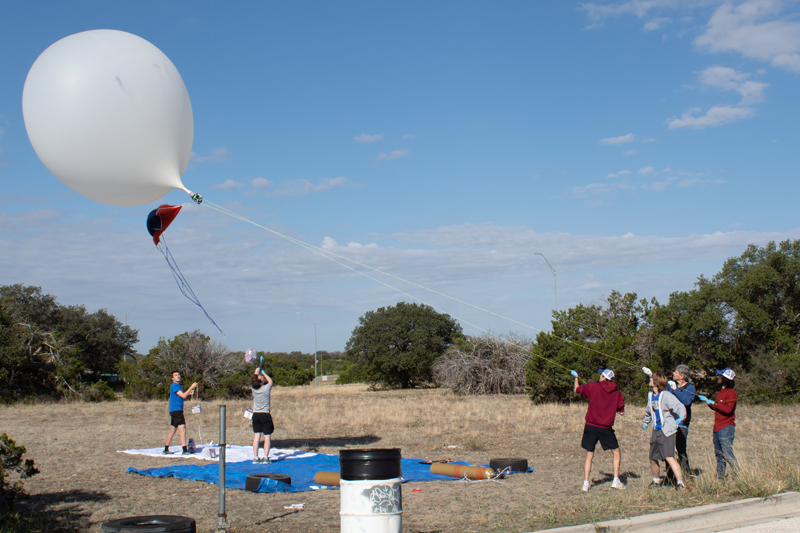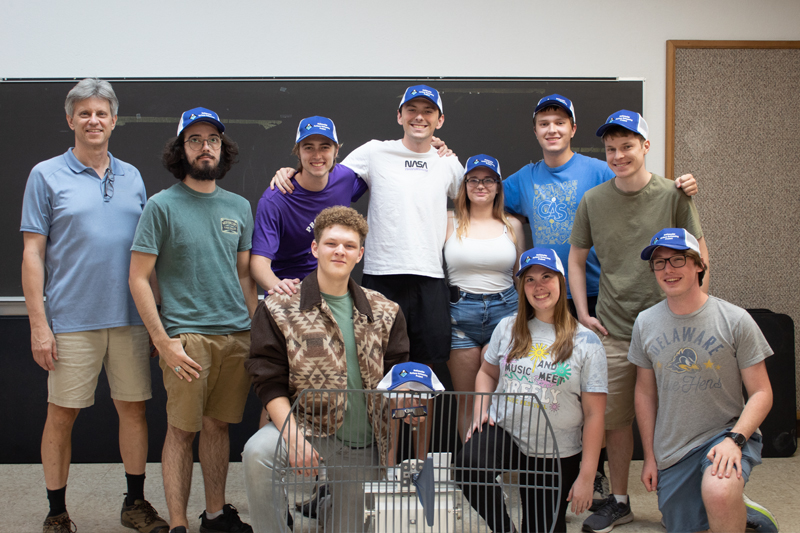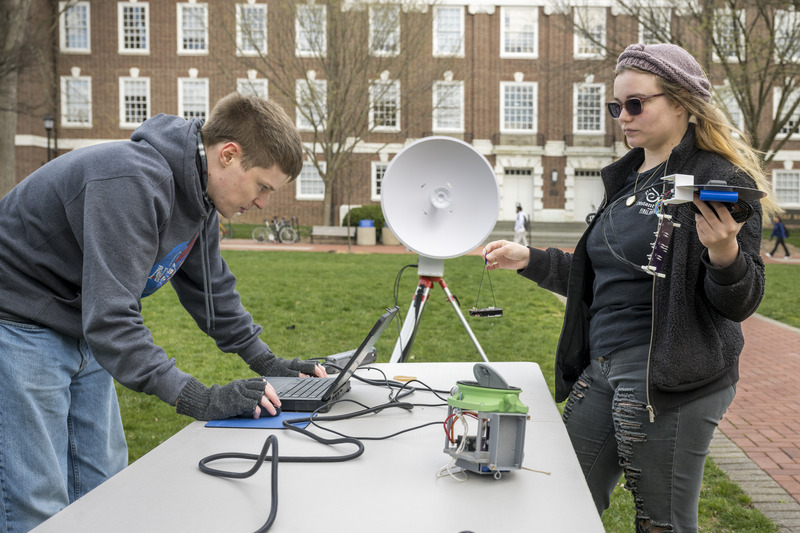

Eclipse Chasers 2024: youtube.com/watch?v=ATGg29BWunU
UD’s Eclipse Chasers head for Texas ‘totality’
Photos by Kathy F. Atkinson and courtesy of Beatrix Nowak and Jarrod Bieber April 05, 2024
Students to collect data as part of NASA’s nationwide eclipse ballooning program
Got your eclipse glasses? The certified safe kind? You know sunglasses are not enough to protect your eyes from the sun’s intense radiation, right?
Got your game plan ready? Where you’ll be on Monday, April 8? What time you want to be in place? What you’ll take with you? Who’s going with you?
Do you know how you’ll capture it all? Will you take notes? Photographs? Video? Don’t forget the special eclipse filters that protect your cameras (including the one in your smartphone), your telescopes and your eyes (if you’re looking through a viewfinder).
If you’re part of the University of Delaware’s Eclipse Chasers team, you’re on it. You’re part of the NASA-backed Nationwide Eclipse Ballooning Project, so you’ve been planning and packing for months. You’re headed to Texas, where you aim to experience a total solar eclipse, launch a high-altitude research balloon, track its journey 13 miles into the sky, capture atmospheric data about temperature and altitude and muons (yes, muons — more on them later) and livestream video from your balloon to NASA for a global audience.
“Space is kind of a big deal,” UD physicist Ben Maruca, one of the Eclipse Chasers’ faculty advisers, has said, and the buzz around a solar eclipse — whether it’s a total eclipse or a partial eclipse — just adds to the evidence.
A total solar eclipse occurs when the moon comes between the Earth and the sun, completely blocking the light of the sun for a few minutes. The skies grow dark, crickets are fooled into thinking it’s time for their nocturnal chirping and — in some places — the temperature drops a bit.
“Totality” — as that experience is known — will be visible in a narrow track that advances through parts of Mexico, 13 states in the U.S. and parts of southern Canada.
The Eclipse Chasers and faculty adviser Edmund Nowak, chair of the Department of Physics and Astronomy, plan to observe the eclipse in Texas, which is where “totality” starts in the U.S.

At UD, skygazers will see a partial eclipse, with almost 90% of the sun obscured by the moon. Certified eclipse glasses are a must.
A partial solar eclipse is a remarkable and exciting experience. But seeing a total solar eclipse takes it to a whole ’nother level, especially if you’re drawn to astrophysics the way Jarrod Bieber, a sophomore physics major from Middletown, Delaware, is.
“I’m fascinated with all manner of phenomena that occur in outer space,” said Bieber, a member of the Eclipse Chasers team. “So I was going to work on any project that gave me an opportunity to go to Texas and see the totality in person. Anyone that has seen it says it is an amazing, mind-blowing experience — some say a life-changing experience.”
Nowak says he had a “Woodstock” moment when he took his family to Clemson, South Carolina, to see a total solar eclipse. And, sure enough, it has changed some lives.
A Woodstock moment, for those who may not get the reference, is a time when you know you are with “your people,” — friends, family and strangers alike — all celebrating a common joy, as thousands did during the three-day Woodstock music festival in 1969.
Nowak saw huge crowds that day in 2017, all experiencing a stellar phenomenon — something worthy of the word “awesome” — that requires no Ph.D. or special training to appreciate.
He saw student-led research balloon groups there, too. And as a professor and researcher, he recognized that the NASA-backed Nationwide Eclipse Ballooning Project, led by Montana State University, could be a great experience for UD students.
He started helping UD students launch tethered balloon flights from the fields of UD’s College of Agriculture and Natural Resources and they have done those launches every fall.
“Tethered balloons are like a 500-foot kite that we can pull down,” he said.
Untethered balloons — unattached to ropes and reliant on remote computer-based controls — can ascend much farther into the atmosphere. The Eclipse Chasers’ untethered balloons now reach 70,000 feet into the stratosphere.
Nowak said UD physicist John Clem also launches research balloons in his study of cosmic rays. Those balloons are enormous and have little in common with the Eclipse Chasers’ balloons. It takes cranes to lift them, for example, and the satellites and technology used are much different.
Birth of the Eclipse Chasers
To build the Eclipse Chasers, Nowak recruited a diverse group of students through UD’s Society of Physics Students, which also has engineering students in its membership. The team has gained momentum, experience and expertise along the way, perhaps especially when things didn’t go as planned.

It also has another member — Beatrix Nowak — who brings the kind of communication skills critical to every research project. Trixie, as she is called, is an English and media communication major. She is also Professor Nowak’s daughter.
She was concerned that her dad’s role as chairman of his department had taken him away from the research he loved in condensed matter physics.
“That was his favorite part of being in physics,” she said, “and I told him, ‘You’ve got to get back into research.’ I’m glad he adopted this project.”
“I am a lab rat by nature,” Professor Nowak agreed. “Being in the lab, even in this episodic way, is very satisfying and rewarding.”
And now it’s work they enjoy together, with Trixie capturing video and photos and writing accounts of the work the team has done.
A big year
The team has done a lot over the past year.
Last spring, Nowak taught a course on scientific high-altitude ballooning, which provided a primer on the theory and fundamentals of the work.
In August, the team launched a practice flight from Samuel Lewis State Park near York, Pennsylvania. It was their first launch of an “untethered” balloon, and it rose to an altitude of about 25,000 feet before starting its descent. Tracking devices helped students find its landing place — about 50 miles away in North East, Maryland, just a few yards from a chicken coop. Let the record reflect that no chickens were harmed.
In October, the team traveled to Junction, Texas, to launch a balloon during the Oct. 14 annular solar eclipse. An annular eclipse — sometimes called a “Ring of Fire” eclipse — is not a total eclipse because the moon is too far from the Earth for its apparent size to fully eclipse the sun, and the sun’s outer atmosphere remains visible. They launched the balloon from a pull-off area near a highway, wrestling with gusty winds to get the balloon under control.
On Monday, April 8, they hope to experience a total eclipse, the Super Bowl of eclipses. Eclipses occur often somewhere around the globe. But there won’t be another total solar eclipse visible on U.S. territory until 2044.

This time, Nowak said, they hope to launch from a regional airport. If the weather cooperates and the winds aren’t too gusty, it could be an ideal spot.
Nowak said the project gives students extraordinary experiences and new insight into how they can apply what they’re learning in classes to many kinds of challenges.
“For the physics majors in particular, it helps them understand how to put together an experimental program,” he said. “The system is too complex for one individual to get it all set and put together and deployed. You need that team effort.”
Team effort is an essential piece of the Nationwide Eclipse Ballooning Project, which includes students from more than 70 institutions, divided into 53 groups, which are subdivided further into “pods.” UD’s pod includes the University of Bridgeport, Drexel University and Olin College, among others.
It's primarily an engineering project, Nowak said.
“They’re kind of experts,” he said. “They have each designed certain subsystems.”
Data gathered by UD’s balloon will support atmospheric research in general and the search for eclipse-induced atmospheric gravity waves in particular.
The cosmic watch
The Eclipse Chasers will collect data that leverages Blue Hen research, too. The team has assembled a customized particle detector with assistance from Spencer Axani, assistant professor of physics and astronomy, who studies particle physics, cosmic rays and nuclear physics.
Millie Dill, a physics major from Milford, Delaware, and Allison Fantom, a senior physics major from Wappingers Falls, New York, worked out a way to include that detector, which they call a “cosmic watch,” in the balloon’s payload. Dill worked on the portable, battery-operated detector during UD’s winter break.
A cosmic watch is nothing like a wristwatch or a fitness tracker. It’s a detector, a sensor, capturing observations the way you might on a whale watch expedition or as part of a bird watchers’ backyard census.
This instrument will detect the presence of extraordinary particles called muons (pronounced MOO-ons).
They want to know if the conditions found in a total solar eclipse will change the rate at which the muons strike the detector. This is an opportunity to collect information that might help us understand more about muons.
What is known is that muons are fundamental particles, not composed of any smaller particles. They are subatomic — which means they are smaller than atoms — and they have a very short lifespan, about two-millionths of a second. To understand that, consider that it takes about a third of a second to blink your eyes one time. By then, 700,000 muons have lived and died.
You might think they can’t get far in that ridiculously short lifespan, but you would be ever so wrong.
Muons are born when cosmic rays (high-speed particles from our sun, from outside our solar system or from distant galaxies) collide with other particles (such as gas, dust, smoke and other pollutants) in Earth’s atmosphere. Muons travel at almost the speed of light and cover a great distance during their short lifetime, passing through almost any substance and reaching as far as a mile below the surface of the Earth. When their lives are over, they decay into electrons and/or neutrinos.
Mission critical solutions
On Monday, during the eclipse, Dill and Bieber will work at the team’s ground station, its central communications device that connects the balloon’s instruments with an Iridium GPS tracker, controlled by Iridium’s satellite network.
How do you communicate with a helium balloon when it’s 13 miles up in the sky? Bieber sends an email to the Iridium network, from which the nearest Iridium satellite will beam a message to a modem flying with the balloon, which tells the balloon’s instruments what to do and when.

For example, the satellite will send commands, telling the balloon’s payload to open a vent to release helium when the balloon has reached the optimal altitude. That stops the balloon’s ascent and allows it to float steadily at that height.
Then, when the total eclipse has moved on, another email will be sent to the satellite, which will relay the command to cut the balloon free of its payload string. Parachutes will slow the descent of the payloads and prevent damage to the contents.
UD’s Colin Moses, a sophomore from Aberdeen, Maryland, majoring in physics and applied mathematics, worked extensively on the payload containers that hold the sensors and other electronic instruments that are so critical to collecting data. There were plenty of complications to sort out.
For example, how do you pack those instruments snugly into containers without breaking anything? How do you cool the containers if they get too warm and how do you control the moisture inside the containers so condensation doesn’t mess with the instruments?
Moses figured out a way to customize the containers and chain-link them together, engineered little fans that could cool the payload containers and found a way to use silica packets to keep moisture from messing with the delicate electronics. He also created a new mount system for the camera system.
Not a bad start, especially considering this was Moses’ first research project at UD.
“It has been a good experience to take what I’ve been learning and apply it,” he said.
Dill said the engineering aspects of the work were especially appealing to her.
She said she has worked mostly on the Raspberry Pi components, using that small, low-cost computer system to enable data collection and control the balloon’s camera to livestream video to NASA’s channel.
“What I was looking for in joining the engineering team was to see how I can face a problem — to see how I would fix it, what resources we need, and the general research, too.” she said. “I did a lot of reading, and the team from Montana State provided each step of the process. It was really interesting and continues to be.
“You need a growth mindset with science,” she added. “You have to be able to work past your failures.”
And whatever happens Monday, Bieber is excited about the possibilities that lie ahead.
“This is a NASA-sponsored project, and I’m a fan of that agency,” he said. “Maybe I’d like to be employed there someday.”
Blue skies, Eclipse Chasers all.

Contact Us
Have a UDaily story idea?
Contact us at ocm@udel.edu
Members of the press
Contact us at 302-831-NEWS or visit the Media Relations website

